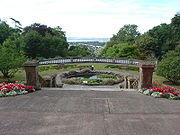
Brunel Manor
Encyclopedia

Devon
Devon is a large county in southwestern England. The county is sometimes referred to as Devonshire, although the term is rarely used inside the county itself as the county has never been officially "shired", it often indicates a traditional or historical context.The county shares borders with...
seaside resort of Torquay
Torquay
Torquay is a town in the unitary authority area of Torbay and ceremonial county of Devon, England. It lies south of Exeter along the A380 on the north of Torbay, north-east of Plymouth and adjoins the neighbouring town of Paignton on the west of the bay. Torquay’s population of 63,998 during the...
.
Ownership history
The Manor, along with its gardens were designed by Isambard Kingdom BrunelIsambard Kingdom Brunel
Isambard Kingdom Brunel, FRS , was a British civil engineer who built bridges and dockyards including the construction of the first major British railway, the Great Western Railway; a series of steamships, including the first propeller-driven transatlantic steamship; and numerous important bridges...
to be his retirement home. It is said that while Brunel was surveying for the Great Western Railway that he discovered the area, where he and his family later spent many holidays in the town. He eventually purchased the plot of land with a view to designing and building his dream home to which he would retire.
Unfortunately the great engineer never saw the house or gardens finished due to his death in 1859. Brunel had already imported large quantities of Oregon Pine timber and the foundations were laid, so a buyer had to be found who was prepared to work with what was already done. It was briefly owned by John and Robert Vicary but the site stood idle until acquired by paper manufacturer James Crompton in 1873. He re-designed the exterior appearance from Brunel's Italianate style to the French style and built the present house on Brunel's foundations. He also purchased a large amount of the surrounding land, the estate amounting to some 200 hectares (500 acres) at that time and named as Watcombe Park.
During the following 90 years the house was variously occupied by Charles Ichabod Wright
Charles Ichabod Wright
Charles Ichabod Wright was a British banker and Conservative politician who sat in the House of Commons from 1868 to 1870....
, Mr James Peck, Sir John Edwards-Moss
Edwards-Moss Baronets
The Edwards-Moss Baronetcy, of Roby Hall in the County of Lancaster, is a title in the Baronetage of the United Kingdom. It was created on 23 December 1868 for Thomas Edwards-Moss. Born Thomas Moss, he had assumed by Royal license the additional surname of Edwards in 1851, having married Amy...
, Frederick James Lund, Thomas John Crossman, Stockwell Teacher Training College (evacuated from London during World War II), and the Holiday Fellowship (who gave the estate its current name). Various portions of the estate were sold off with each transaction and by 1940 just 4 hectares (10 acres) of land were left.
The house and gardens were purchased in January 1963 for £28,500 by The Woodlands House of Prayer Trust who relocated from premises in Eastbourne
Eastbourne
Eastbourne is a large town and borough in East Sussex, on the south coast of England between Brighton and Hastings. The town is situated at the eastern end of the chalk South Downs alongside the high cliff at Beachy Head...
.
Present day use
Brunel Manor is still operated by The Woodlands House of Prayer Trust as a Christian holiday, retreat and conference centre. The house has been considerably extended for this purpose during those years, and the gatehouse lodge was re-purchased from private owners in 1986.About the building
The Manor was recorded as a Grade II Listed Building in 1988 due to its historical and architectural significance. It is mainly constructed of local grey limestone with window surrounds and other decorative features in Bath StoneBath Stone
Bath Stone is an Oolitic Limestone comprising granular fragments of calcium carbonate. Originally obtained from the Combe Down and Bathampton Down Mines under Combe Down, Somerset, England, its warm, honey colouring gives the World Heritage City of Bath, England its distinctive appearance...
. The original house was mostly built as three storeys (a fourth over the entrance tower). A hall in matching style was later added to the east; available dates for this addition are vague, quoted by Brunel Manor's own information document as being between 1907 and 1923.
The Fire Precautions Act 1971 came into force in 1972, when hotels and boarding houses were the first class of premises to be designated. Under the Fire Precautions (Hotels and Boarding Houses) Order 1972, Statutory Instrument (SI) 1972 /238) any premises where there was sleeping accommodation for more than 6 persons (staff or guests) or sleeping accommodation above the first floor required a fire certificate issued by the local fire authority. This required partitioning to be built across previously open galleried landings, fireproofing of many doors and door frames, removal of combustible material, and installation of a fire alarm system. This means that many original features are now hidden behind plasterboard, corridors divided by modern fire doors or internal views seen through wired glass. The scale of this internal alteration can be appreciated by its cost in 1973 of £9000, the same as the average price of a house bought in the UK that year.
Between 1980 and 1998 two loft conversions and four extensions were added which are in a more modern style, built to serve the present day needs of the holiday centre.

